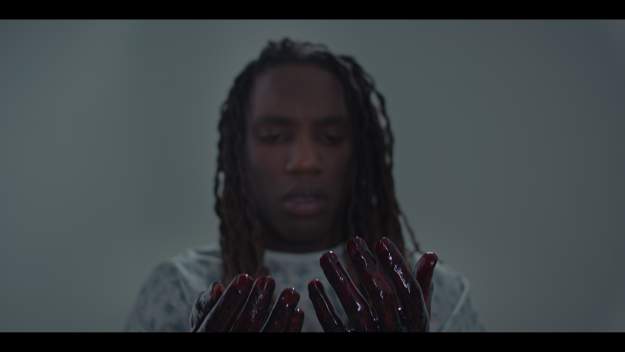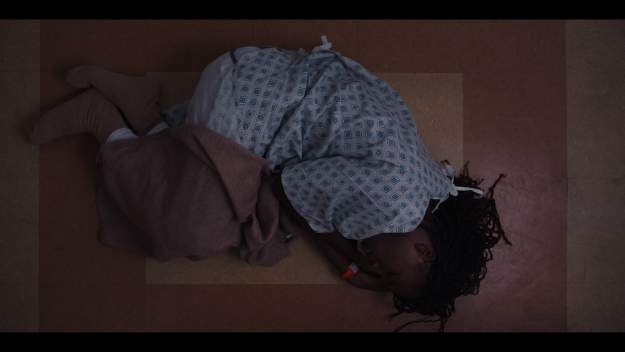Through the long and dark corridors of Alameda County Hospital lurks the manifestation of an urban legend that haunts victims of failed suicide attempts. If no suicide note has been left by the victim, Hopeless Hattie preys on these patients and keeps them for her very own. Such is the premise for the short horror film The Quiet Room, directed by Sam Wineman, which has been getting lots of attention as it makes its rounds around the festival circuit.
We first discovered that The Quiet Room was coming after its incredible teaser was released last year. But after attending a recent screening at Orange County’s award-winning indie/art house theater The Frida Cinema, I can attest to the fact that the chilling trailer for The Quiet Room is only the surface of this haunting story that walks the muddy line between nightmare and reality.
The story follows Michael, played by Jamal Douglas, a gay man whose suicide attempt lands him in the 51/50 ward. As Michael meets hospital mates, Hunter (Kit Williamson), Joe (Chris Salvatore), and Rachel (Barkley Harper), he begins to learn and experience the traumatizing energy that is Hattie—the incarnation of the darkness that is inside of each one of us.
Hattie is played flawlessly by RuPaul’s Drag Race All Star Season 2 queen Alaska Thunderfuck—and yes, her makeup IS terrible!

The film also features original scream queen Lisa Wilcox from the Nightmare on Elm Street franchise as Amy, the nurse who attempts to soothe Michael’s sorrows, and Brian McCook, also known as Yekaterina Petrovna Zamolodchikova—but your dad just calls her Katya. Katya, from RuPaul’s Drag Race season 7 and All Stars Season 2 plays David, an eerie nurse who gets sucked into the turmoil that is Hattie’s torment.

As the story unfurls, you learn of Michael’s inner struggles that have unleashed the wrath of Hattie on the entire hospital. It is the terror of dying a gruesome death at the mercy of Hattie that turns his desire to die into a fight for survival. But can he save everyone—including himself?
With all the horror films I have seen, it was refreshing to see a gay lead that pushes the plot forward—not to mention a person of color! And even though the story is wrapped up into one package, the ending leaves you with a ‘what if?’ sensibility that can further be explored with a follow-up project or, dare I say, feature-length version. Yeah, we want more Alaska and Katya! And Jamal is really nice to look at too (don’t blink or you’ll miss the butt shots).

But you may be wondering: Where can I watch The Quiet Room? Well—that’s tricky. Right now the film is making its way through festivals, being regarded both as a great story that sheds light on mental health as well as a frightening tale to beware. So keep an eye out on the film’s website and social media for upcoming festival screenings because you won’t be seeing it on Netflix or DVD anytime soon.
I caught up with Sam Wineman after watching The Quiet Room to find out more about the mastermind behind the film that is bringing new meaning to ‘scream QUEEN’:
How did the idea for The Quiet Room come about?
The Quiet Room began with our monster. I wanted to find a way to talk about depression that externalizes that experience; how cold depression can feel, the way that it isolates, how dangerous its comfort is. Then I wrote a creature who operates by those characteristics. I created an urban-legend style myth about her; one that patients at a hospital might pass along to one another after dark. That’s how Hattie was born.
I saw some homage to horror greats in the film–who are some of your horror inspirations?
Wes Craven, without a doubt. And not just Craven, but I’d say the Elm Street series as a whole. They reinvented Freddy for each scare and really, their imagination was the limit. That’s why it was especially exciting getting Lisa Wilcox on board. As Alice, she survives A Nightmare on Elm Street 4 and 5, both legendary installments, and happens to be one of my all-time favorite Final Girls. My favorite film, Bob Clark’s Black Christmas, is something that disturbs me to this day. It terrorizes audiences without depending on jump scares. Clark gets into your head with just a telephone call and the placement of his camera.

The Quiet Room’s main character, Michael, is gay—how important was it for you to write this character for a horror film?
I grew up on horror, identifying with the fierce Final Girls of the 1980s. Many, like Laurie Strode in Halloween, were outsiders you may underestimate, but all found the strength to fight back despite insurmountable odds. While so many horror films were written or directed by gay men, we rarely had actual queer-identified characters, and often when we did, they were a tired stereotype, or worse: the killer. Explicitly gay characters are a void in mainstream genre films and it’s very important we address that. How do you get through 19 Marvel movies without a queer relationship that doesn’t end up on the cutting room floor? Audiences are ready for queer leads. We are ready for a Final Gay. And when a studio is brave enough to make that jump, the money will follow. I continue to say it every chance I can: the time for queer horror is now.

How was the casting process for The Quiet Room?
Casting for The Quiet Room was thorough, and ultimately, very rewarding. I wrote the part of Hattie with Alaska in mind, so I was overjoyed when she joined our cast. I reached out to actors whose work I was a fan of, like Lisa Wilcox, Chris Salvatore, and Kit Williamson, because I knew they’d be great in their respective parts. Our lead, Michael, is in just about every moment of the film, so we knew we needed someone strong to carry that. When Jamal Douglas came in to read for the part, his performance moved me to tears. It was as if the character had lept off the page and was standing right in front of me. I had similar experiences with Barkley Harper and Stephanie Kerbis, both incredible actors who I knew, as soon as they read, were getting the part. It really was a situation where I got everything I could have wanted.
How did Alaska and Brian McCook (Katya) get involved with the project?
I was already in touch with Alaska’s manager because of a music video pitch for another client, so I reached out through him. Alaska loved the idea, and she hopped on the phone to hash out the details – the character, the look, what’s behind the story. It all just fell together after that. Brian McCook and Alaska had the same rep at the time and there was a quick break in Brian’s schedule, so the timing just worked out for both of them. This was right on the heels of All Stars 2, so you can bet I was excited to get the two of them in a scene together!
Other than festivals, is there any other way people can watch The Quiet Room?
Right now, there isn’t. Film festivals really like to program content that isn’t available anywhere else, so for the time being, it’s going city to city. We are posting every screening we get on our social media as soon as we are allowed to announce it, so fans who follow us there will have the chance to snatch up tickets.
What kind of advice would you give to LGBTQ+ artists who are seeking an avenue for their voice?
Create explicitly queer art. Don’t worry about if the world is ready for it yet because if you’re breaking new ground, it won’t be. Collaborate with other LGBTQ+ artists. Fill your sets with queer filmmakers, women, and people of color. The future of film is diverse and we can help each other get there. If there is a movie you want to see, don’t wait for it to happen – make it yourself.
All blood and gore aside, is there a message to be found in The Quiet Room?
Crossing themes of mental health with supernatural horror leave The Quiet Room rich with allegory. While I definitely created this film with meaning, I like to leave it up to the audience to find it for themselves.

What are the plans for The Quiet Room after the festival circuit?
While The Quiet Room stands nicely on its own, it was always made to lead into a larger feature film. I’m working on a feature adaptation that explores the dark underbelly of the hospital, and – of course – gives us more Hattie. Distributing the short would be a lot of fun but I think a queer horror franchise couldn’t be more timely.
Until you get to your twisted self to a screening of The Quiet Room, feast your eyes on the theatrical trailer that will DRAG you out of your wig:
Horrorbuzz.com, a gay owned and operated horror site, has invited The Quiet Room to be a part of the “Screaming Room” of Midsummer Scream! Director Sam Wineman and Alaska have also been invited to present on the queer community in horror. The event will take place on Sunday, July 29th in Southern California.
The Quiet Room deals with extremely sensitive topics such as mental health and suicide. The film’s site expresses the following:
Often times in film, particularly the horror genre, people suffering from mental illness are misrepresented or worse; villainized. Our story features an unlikely group of outcasts coming together to overcome a seemingly impossible force. The Quiet Room is an opportunity to externalize a struggle that is internal by nature and show that there is hope even in the darkest of places.
Suicide Hotline: Call 1-800-273-8255
http://suicidehotlines.com/
Keep up with The Quiet Room:
https://www.thequietroomfilm.com/
Instagram: @TheQuietRoomFilm
Twitter: @QuietRoomFilm
Facebook: http://facebook.com/thequietroomfilm




